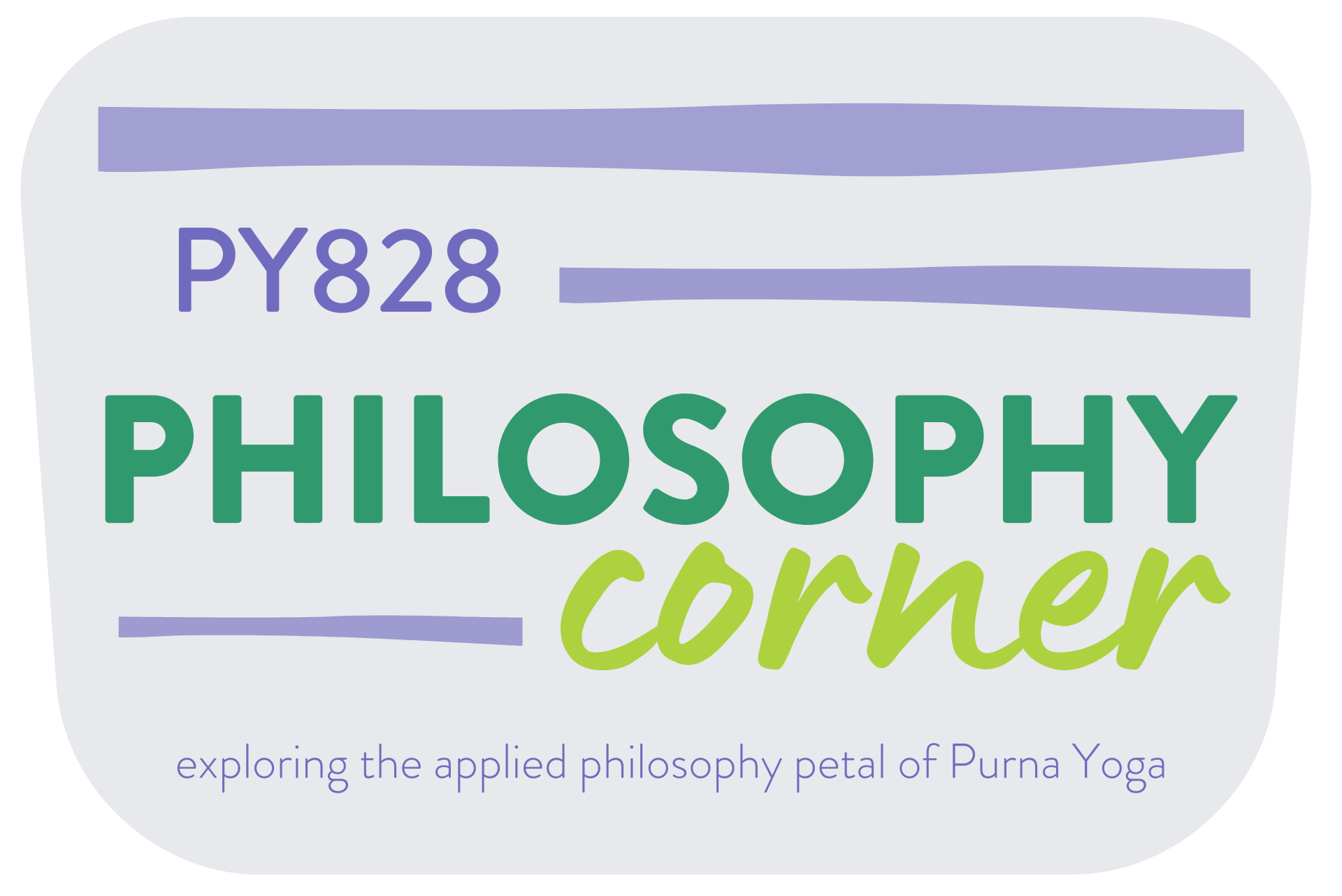
17 Jun 2024 PY828 Monthly Topics 2024
In class and in social media, we’ve been exploring different topics each month throughout 2024. Each topic offers myriad ways to examine and deepen your practice and serves as an entry into the foundational texts of Purna Yoga. Catch up with a recap of what we’ve covered so far:
January: Compassion
Assembled almost 2000 years ago, the Yoga-Sutra of Patanjali is a concise collection of yogic wisdom gathered from various traditions and marks the first time these teachings were written down and codified into specific actions.
We begin the new year by contemplating Sutra 1:33, sometimes called the “four locks and keys” sutra. In it, Patañjali describes four locks, or the four types of emotional disturbances all human beings face, and the four keys that open those locks.
The four locks are sukha (happy people), dukha (unhappy people), punya (the virtuous), and apunya (the not-so-virtuous); the four keys are maitri (friendliness or loving-kindness), karuna (compassion), mudita (delight), and upeksha (disregard or equanimity).
Sutra 1:33 can be translated as, “Consciousness settles as one radiates friendliness, compassion, delight, and equanimity toward all things, whether pleasant or painful, good or bad.”
Another translation reads, “By cultivating attitudes of friendliness toward the happy, compassion for the unhappy, delight in the virtuous, and disregard toward the wicked, the mind-stuff retains its undisturbed calmness.”
Another reads, “Infusing the mind with friendliness, compassion, cheerfulness, and uninvolved observation in relation to those living a happy, miserable, virtuous, and non-virtuous life respectively, results in reclaiming a pristine state of mind.”
Patanjali is describing the ways in which we can follow the path of yoga, and working closely with any of the four keys will enrich one’s practice. For the month of January, we are specifically focusing on the key of karuna (compassion).
Cultivating karuna clears the mind and restores serenity. Compassion helps us be mindful of our own and others’ basic humanity; it helps us to treat ourselves and others with kindness and sensitivity. Nurturing a sense of compassion within us allows us to remain cheerful, calm, and quiet in all situations and fosters an inner stillness that bolsters us for the work of responding to the turmoil of the world from a place of peace and love.
It’s not difficult to find suffering around us, whether in news stories from far away or in our own circles of family and friends. In any case, the call is the same: Sutra 1:33 invites us to respond to unhappiness with compassion, with empathy rather than pity. Likewise, when we ourselves are suffering, we should offer ourselves compassion instead of critique, using this key to reconnect with the stillness and love and light that is always within us.
February: Friendliness
Assembled almost 2000 years ago, the Yoga-Sutra of Patanjali is a concise collection of yogic wisdom gathered from various traditions and marks the first time these teachings were written down and codified into specific actions.
Sutra 1:33, sometimes called the “four locks and keys” sutra, describes four locks, or the four types of emotional disturbances all human beings face, and the four keys that open those locks. One translation reads, “Consciousness settles as one radiates friendliness, compassion, delight, and equanimity toward all things, whether pleasant or painful, good or bad.”
Patanjali is describing the ways in which we can follow the path of yoga, and working closely with any of the four keys will enrich one’s practice. For the month of February, we are specifically focusing on the key of maitri (friendliness).
The word maitri is derived from mitra, which itself is composed of two parts:
mi – violence, destruction, disintegration
and
tra –the power of protection, nurturance, the guiding and protective force.
Mitra refers to the core nature of friendship and friendliness: an attitude of protection against violence or destruction, both within ourselves and toward others.
This sutra directs us to hold a feeling of friendliness toward the happy, which would on its face seem an easy task. But consider how some part of us always wants to respond to the good fortune of others with animosity—envy for what they have fear and insecurity for what we don’t have in comparison, perhaps a sense of competition to hoard more happiness.
These natural responses unsettle the mind and divert us from the path of yoga. But by cultivating an expansive feeling of friendliness toward the happy, we also extend protection and nurturance to ourselves, freeing our minds from animosity and restoring serenity.
A gesture of friendliness toward another is also an act of care and protection for oneself.

March: Patience
Yoga begins with stillness. The very first three verses of the first of Patanjali’s Sutra read, “Now, the teachings of Yoga. Yoga is to still the patterning of consciousness. Then pure awareness can abide in its very nature.”*
Sutra I continues later, in verses 12-14: “Both practice and nonreaction are required to still the patterning of consciousness. Practice is the sustained effort to rest in that stillness. This practice becomes firmly rooted when it is cultivated skillfully and continuously for a long time.”*
Sustained effort, cultivated continuously for a long time… Sound familiar? Though never explicitly naming it, the Sutra make it clear that the practice of yoga requires PATIENCE, the topic we’ll be exploring throughout this month in class, meditation, socials, and our newsletter.
In the words of The Mother, “To realise anything one must be patient. And the vaster and more important the realisation, the greater the patience must be.”
All of yoga is rooted in practices that require our patience. We live in a culture that values both instant gratification and images of perfection, both of which stand at odds with patience. Yoga is a never ending practice with no end point; patience helps redirect our attention away from the 30-minute miracles and flawless results promised in media and toward our lifelong commitment to the yogic path.
Perhaps the most difficult application of patience is with ourselves. We wouldn’t shame a child for falling off a bike or insult a friend for running late to a coffee date, but we freely criticize and belittle ourselves for “failing” to sustain a difficult pose or tick every last task off our (probably too long) to-do list.
In the last two months, we have explored the topics of compassion and friendliness, attitudes that can be inroads to patience.
When we cultivate a gentle kindness toward ourselves and others and just the way life plays out in general—when we cultivate patience—we are creating space for stillness, continuously renewing the foundation of our practice.
*Chip Hartranft translation
April: Connection
Yoga, at its most fundamental, can be viewed as a practice of connection. The word ‘Yoga’ itself is derived from the Sanskrit root ‘Yuj’, meaning ‘to join’ or ‘to yoke’ or ‘to unite’, and the practice of Yoga leads to the union of individual consciousness with that of the Universal Consciousness.
You can hear it in class every day: our teachers may invite you to connect the movements of Surya Namaskar with the flow of your breath, or prompt you during meditation to connect the clear white flame you envision at your heart center with a beautiful feeling. We connect the energetics of asana with the musculoskeletal movements our bodies are making, and those aspects when joined together enhance our experience of the pose. We connect with one another when we chant Om at the beginning and end of class or when we wipe out the sink in the studio bathroom for the next person.
And as with all aspects of Yoga, the practice of connection carries beyond our mat, out of class and into our everyday experience of life—and it enriches everything we do. When we pause and recenter our attention at any point in the day, we (re)connect with ourselves, simply and sweetly. Connecting with family and friends over a shared meal nourishes the body and the spirit. Making a point to connect with strangers—offering a friendly smile, thanking a cashier, holding a door for someone—fosters a sense of community in our little corner of the world.
What might shift if you approached your yoga practice as a continuous search for opportunities to connect more deeply, both inwardly and outwardly?
How might your relationship with yourself and the wider world grow and evolve?
Where have you missed the chance to feel a deeper sense of connection—and how might you approach that situation differently next time?

May: Beauty
Have you noticed that there are always fresh flowers in every room at the studio? It’s just one small way we invite more beauty into this space, as well as a cheerful reminder to everyone who comes here to look for the beauty that is always around them.
If you are embracing yoga as a spiritual discipline, it may at first seem counterintuitive for us to value beauty so highly. Isn’t spirituality about asceticism and rejecting superficial concerns? On the contrary, all teachers in the Purna Yoga lineage emphasize that appreciation for beauty is a fundamental part of the practice itself.
Sri Aurobindo tells us: “Beauty is Ananda [bliss] taking form—but the form need not be a physical shape. One speaks of a beautiful thought, a beautiful act, a beautiful soul. What we speak of as beauty is Ananda in manifestation…”
The Mother says: “In the physical world, of all things it is beauty that expresses best the Divine…. Beauty interprets, expresses, manifests the Eternal. Its role is to put all manifested nature in contact with the Eternal through the perfection of form, through harmony and a sense of the ideal which uplifts and leads towards something higher.”
Beauty can be a helpful tool in our practice. For example, beauty can be one way to explore the niyama of Santosha [contentment]. Seeing the beauty in what we have helps us realize that we already possess all that we need and can be content without acquiring more.
Try this with another niyama, Saucha [cleanliness]. Rather than thinking of your regular household chores as repetitive drudgery, what happens if you see them as a repeated offering of beautification to your home and its inhabitants?
In his book Fire of Love, Purna Yoga co-founder Aadil Palkhivala writes, “A practitioner of Purna Yoga is one who cultivates a love for beauty in its manifold expressions. Practitioners are encouraged to study the beauty of art, the magic of music, and the power of poetry.”
What are some ways you might bring beauty—beautiful things, beautiful thoughts, beautiful actions—into your everyday experience? How might your practice evolve if you incorporated a conscious appreciation for all kinds of beauty?
June: Authenticity
This month we’re working with the concept of authenticity.
While last month’s topic of beauty might have seemed too superficial a concern to be part of the spiritual path of yoga, authenticity immediately sounds more like something serious yogis might want to explore.
But it gets tricky. We humans love to label and judge and separate and categorize. We want to rank this or that style of yoga as being more authentic than others. Barrages of marketing urge us to buy products that will make our practice more authentic. We exoticize and appropriate from yogis we perceive to be more authentic.
Our search for authenticity can push us farther away from the truth of our innate joy and connection to all beings, and lends itself all too easily to gatekeeping and reinforcing the harms done by the commercialization and white-centering of modern yoga.
So it’s vitally important that we approach the search for authenticity by actively engaging with the fundamentals of yogic philosophy. One of the most potent ways is by working with Avidya, the first of the five klesha.
Avidya is most commonly translated as ignorance, and is the ultimate source of all suffering. Sutra II:4 makes it plain: “Not seeing things as they are is the field where the other causes of suffering germinate…” (Hartranft translation).
What does Avidya keep us from seeing correctly? Nothing less than our own authenticity, our own true nature. As Aadil writes in Fire of Love, “We are ignorant of the fact that we are, in essence, pure love.”
How might we work to overcome this ignorance?
One way is through the fourth niyama: Svadhyaya, or self-study. Honestly and openly reflecting on our own choices and how they either bring us closer to our true nature or pull us back into ignorance orients us toward authenticity in an expansive and loving way.
Svadhyaya also encompasses other types of study, and is an invitation to engage with the foundational texts of Purna Yoga as well as other illumined works with messages you would like to incorporate into your consciousness. What are some of your go-to texts when you want help reconnecting with the authenticity of your big-s Self?



Sorry, the comment form is closed at this time.